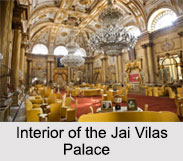 Jai Vilas Mahal which is also known as the Jai Vilas Palace was established by the Scindia people. It is still the residence of Maharaja of Gwalior and his descendants the former royal Maratha Scindia dynasty. It was at first built as a palace which is now turned into a museum.
Jai Vilas Mahal which is also known as the Jai Vilas Palace was established by the Scindia people. It is still the residence of Maharaja of Gwalior and his descendants the former royal Maratha Scindia dynasty. It was at first built as a palace which is now turned into a museum.
Location of Jai Vilas Palace
Jai Vilas Mahal is located in Gwalior in the central Indian state of Madhya Pradesh. It is one of the most popular tourist attractions of Gwalior.
History of Jai Vilas Palace
Jai Vilas Palace was built in the 19th century, in the year 1874 by Jayajirao Scindia, the Maharaja of Gwalior, Madhya Pradesh, with the prisoners from the fort. The most important objective of building this palace was to bring the palace of Versailles to Gwalior. The royal family still resides in the palace.
Architecture of Jai Vilas Mahal
 Jai Vilas Mahal was constructed by Maharaja Jayaji Rao Scindia in 1874 at a cost of Rs. 1 crore. Jai Vilas Palace is a fine example of European architecture, designed and built by Sir Michael Filose. The first storey is Tuscan, the second storey is Italian-Doric and the third storey is Corinthian. It is mostly famous for its large Durbar Hall. The inside of the Durbar Hall is decorated with gilt and gold furnishings and a huge carpet and enormous chandeliers. It is 100 feet long, 50 feet wide and 41 feet in height.
Jai Vilas Mahal was constructed by Maharaja Jayaji Rao Scindia in 1874 at a cost of Rs. 1 crore. Jai Vilas Palace is a fine example of European architecture, designed and built by Sir Michael Filose. The first storey is Tuscan, the second storey is Italian-Doric and the third storey is Corinthian. It is mostly famous for its large Durbar Hall. The inside of the Durbar Hall is decorated with gilt and gold furnishings and a huge carpet and enormous chandeliers. It is 100 feet long, 50 feet wide and 41 feet in height.
Cut-glass furniture, stuffed tigers and a ladies swimming pool with its own boat fill the rooms. The vast dining room exhibits the piece de resistance, a mock-up railway with a silver train that carried after-dinner brandy and cigars around the table. A distinctive feature of the palace is the long dining table with a silver train which acts as a trolley and turns on the table in front of the diners.
Attraction of Jai Vilas Mahal
The collection at Jai Vilas Palace Museum includes of leading pair of chandeliers in the world, silver carriage, oil painting by Raja Ravi Verma, Malabar furniture, crystal furniture, palki (Palanquin), pooja ghar, Jacobean furniture, Napolean table, miniature paintings, lithograph, royal old photograph, silver train, Chinese pot, clothes and footwear of the royalty, Jain sculpture, Lord Vishnu bronze statue, Balgopal bronze statue, weapons and more.
One of the most luxurious buildings built then, the museum showcases a collection of objects, artefacts etc belonging in the 19th and 20th century, focusing on art and craft. The collection at the museum has been brought from all around the world. The palace museum also consists of swords that date back to the times of Mughal Emperors Aurangzeb and Shah Jahan. Along with the swords, there is the original shield of Jhansi Ki Rani, Laxmi Bai. Jai Vilas Mahal has 400 rooms from which exclusively 40 rooms are transformed into Jiwaji Rao Scindia Museum.
Visiting Information of Jai Vilas Mahal
The Jai Vilas Palace is easily accessible via road, rail, and air. The journey can be further continued by local taxis and buses. The nearest airport is Gwalior Airport at a distance of 8 kilometres from the city. The nearest railhead is Gwalior Junction, at a distance of 2 kilometres from the palace.



















